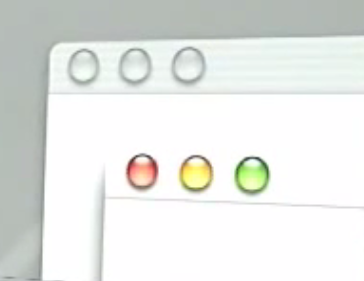So this, you get a little feeling for what AQUA may be like.
現在你們對AQUA可能的樣子有了點感覺了。
So I'd like to just start off you know when you design a new user interface.
我想從設計一個新的用戶界面開始。
You have to start off humbly,
你必須細致入微地開始,
you have to start off saying what are the simplest elements in it, what does a button look like.
你必須從最簡單的元素開始,一個按鈕是什么樣子的開始。
And you spend months working on a button. That's a button in AQUA.
你花了幾個月的時間做一個按鈕。這是AQUA的一個按鈕。
This is what radio buttons look like, simple things.
這是單選按鈕的樣子,很簡單。
This is what check-boxes look like.
這是復選框的樣子。
This is what pop-up lists look like.
這是下拉列表的樣子。
Again, you starting to get the feel of this little difference.
同樣地,你開始感覺到了這個小小的不同。
This is what sliders can look like, right?
這就是滑塊的樣子,對吧?

Now let me show you the Windows.
接下來我給各位展示一下窗口。
This is what the top of windows look like.
這是窗口頂部的樣子。
These three buttons look like traffic signals, don't they?
這三個按鈕看起來像交通信號,不是嗎?
Red means close the window, yellow means minimize the window, and green means maximize the window. Pretty simple.
紅色表示關閉窗口,黃色表示最小化窗口,綠色表示最大化窗口。很簡單。
And tremendous fit and finish in this operating system.
這個操作系統在細節方面做了很多處理。
When you roll over these things you get those, you see them, you know.
當你滾動這些的時候,你會看到這樣的效果。
And when you are not no longer the key window, you know, they go transparent, right?
而當不再是主窗口時,它們會變得透明。
So a lot of fit and finish in this.
所以在細節方面做得很好。
In addition to the fit and finish,
除了細節方面之外,
we paid a lot of attention to dynamics, not only how do things look, but how do they move, how do they behave.
我們花了很多精力在動態上,不僅僅是看起來如何,還有它們如何運動,它們如何表現。











